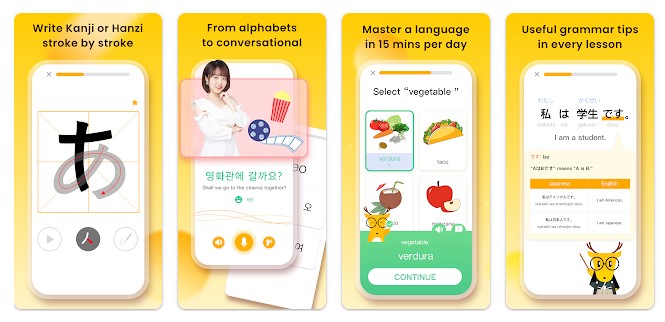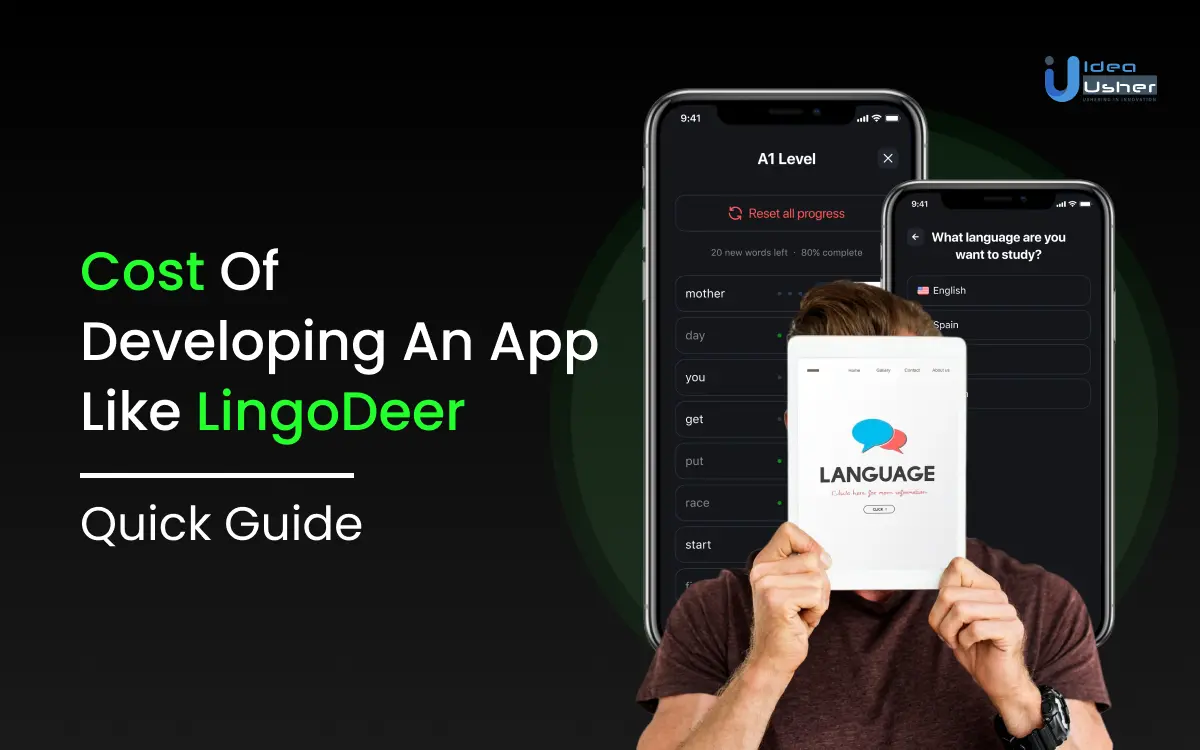For many individuals, mastering a new language is essential for personal and professional growth. However, many people find traditional language courses impractical due to their high costs and rigid schedules. When it comes to apps, they often encounter issues such as a lack of structured lessons, inadequate grammar focus, and monotonous content. These barriers prevent many from achieving their language goals, leading to frustration and a sense of stagnation.
This challenge has led to a rise in demand for flexible and affordable language learning solutions. A report by Technavio highlights this trend, predicting the online language learning market will grow by $42.10 billion from 2023 to 2028. This growth underscores the rising adoption of digital tools designed to make language learning accessible to everyone.
If you’re considering developing an app like LingoDeer, this guide will walk you through the costs involved, detailing the financial aspects of building a language learning app.
LingoDeer: Overview

Since its introduction in 2013 by Wang Zhulong, LingoDeer has been a groundbreaker in the language learning app market. Offering courses in Korean, Japanese, Chinese, French, Spanish, and German, it has set a benchmark with its grammar-centric curriculum, providing learners with a strong grasp of language structures. Unlike many apps that focus mainly on vocabulary, LingoDeer’s emphasis on grammar is a testament to its commitment to fluency.
The app includes HD audio recordings by native speakers, engaging stories, and quizzes that make the learning process interactive and enjoyable. Additionally, LingoDeer provides an offline mode that allows users to download lessons and study without Internet access.
Another significant feature of LingoDeer is its user-friendly interface. It allows users to personalize their study routines, track their progress, and identify areas needing improvement. With its intuitive design and thorough approach, LingoDeer has garnered high ratings and a loyal user base, making it a comfortable and effective choice for dedicated language learners.
What Makes The LingoDeer App Unique?
What sets LingoDeer apart in the crowded language learning app market are its distinctive features that cater to serious learners:
- Lessons: Units covering grammar, vocabulary, and pronunciation.
- Exercises: Activities for listening comprehension, writing, and speaking practice.
- Reviews: Quizzes to reinforce learned material.
- Phrasebook: A collection of common phrases for travel and everyday use.
- Grammar Explanations: Detailed rules for better understanding.
- Audio: Recordings by native speakers for listening practice.
- Writing Practice: Character writing exercises for applicable languages.
- Progress Tracking: Monitors user progress and sets goals.
- Offline Mode: Access lessons without an internet connection.
- Customizable Settings: Options to adjust font size, text color, and other preferences.
Why Do People Love The LingoDeer App?
Based on various reviews, the LingoDeer app is highly praised by users across the globe for several standout features:
- High-Quality Audio: Many users commend the app’s native speaker audio, which significantly improves pronunciation and listening skills.
- Well-structured Lessons: The grammar-focused curriculum and clear explanations simplify the understanding of complex language concepts.
- Offline Availability: The option to download lessons and study offline is a significant advantage, particularly for those with limited internet access.
- Engaging Learning Experience: Interactive stories, quizzes, and diverse lesson formats make the learning process enjoyable and captivating.
- Customizable Settings: The ability to personalize the learning environment enhances user satisfaction and overall experience.
Key Market Takeaways For Language Learning Apps
The online language learning industry is on track for notable expansion, with projections suggesting an increase of USD 42.10 billion and a compound annual growth rate (CAGR) of 19.73% from 2023 to 2028. Several factors are driving this growth:
- The affordability and flexibility of online platforms attract a wide range of learners.
- Companies are increasingly investing in language skills for effective global communication and business growth.
- A rise in international student enrollments worldwide is boosting the demand for language learning resources.

Together, these trends contribute to the market’s growth and diversification, meeting the diverse needs of learners across different sectors.
Further projections indicate that the language learning app market could reach USD 89.53 billion by 2031, with a CAGR of 17.9% from 2024 to 2031. This expected growth underscores the increasing reliance on mobile apps for language acquisition, highlighting promising opportunities for entrepreneurs and developers in the field.
The rapid growth in the online language learning market suggests a promising future. As language platforms become more accessible and crucial for global communication, LingoDeer’s success in both revenue and downloads reflects the growing need for effective learning tools. This trend points to a positive outlook for language education, driven by innovation and user-focused solutions.
Business Model Of LingoDeer
LingoDeer utilizes a well-rounded business model to enhance user engagement and drive revenue. Here’s an overview of their approach:
1. Subscription-Based Model
LingoDeer’s core revenue comes from a subscription-based model. Users can access a limited amount of content for free, providing a glimpse of the app’s features. To unlock the complete range of courses and advanced tools, users need to subscribe. The app offers several subscription plans, including monthly, yearly, and lifetime options. For instance, the monthly subscription starts at about $14.99.
2. Freemium Model
LingoDeer also employs a freemium model. This allows users to use basic features and a limited amount of content at no cost. The freemium approach helps attract new users and gives them a chance to experience the app before deciding to pay for a subscription.
3. In-App Purchases
Beyond subscriptions, LingoDeer offers in-app purchases for additional content. These purchases might include specialized courses, premium features, or extra learning materials. This model lets users expand their learning experience beyond the free and subscription content.
4. B2C And B2B Strategies
Primarily, LingoDeer targets individual users through a Business-to-Consumer (B2C) model. It focuses on self-learners and language enthusiasts. However, LingoDeer is also exploring Business-to-Business (B2B) opportunities. This involves partnerships with educational institutions, companies, and language schools to offer the app as a learning tool for students and employees.
5. Marketing Ad User Acquisition
LingoDeer uses various marketing strategies to attract users. These include social media promotions, collaborations with influencers, and content marketing. The app also employs App Store Optimization (ASO) to improve its visibility and attract more downloads.
What Features Make LingoDeer So Popular Among Its Users?
LingoDeer distinguishes itself with several key features that enhance the learning experience:
1. Grammar-Centric Curriculum
LingoDeer places a strong emphasis on grammar. It offers well-structured lessons and clear explanations, which help users build a solid understanding of language rules and structure. This focus is beneficial for learners seeking to master the intricacies of a new language.
2. High-Quality Native Audio
The app includes HD audio recordings by native speakers. This feature is essential for improving pronunciation and listening skills. By listening to authentic speech, users can better grasp the nuances of the language and practice speaking with a natural accent.
3. Engaging Cultural Stories
LingoDeer incorporates interactive stories that introduce cultural elements while teaching new vocabulary and grammar. These stories make learning more engaging and provide valuable context that enhances comprehension and retention.
4. Built-In Flashcards
To support vocabulary learning, LingoDeer provides flashcards. These tools help users review and remember new words more effectively, reinforcing their language skills through repeated practice.
5. Offline Mode
The app allows users to download lessons and study offline. This feature is particularly useful for those who travel or have limited internet access, enabling continuous learning regardless of connectivity.
6. Customizable Learning Environment
LingoDeer offers various customization options. Users can adjust background colors, select different script types, and choose narrator voices. This flexibility enhances the learning experience by allowing users to tailor the app to their personal preferences.
7. Cross-Device Synchronization
The app synchronizes progress across multiple devices. Users can switch seamlessly between their phone, tablet, and laptop, ensuring that their learning progress is consistently updated and accessible.
Innovative Features That Can Enhance An App Like LingoDeer
To further improve an app like LingoDeer and provide a more enriching learning experience, consider integrating the following innovative features:
1. Language Immersion Mode
This feature would change the app’s interface to the target language. Users would interact with the app entirely in the language they are learning, helping them practice language skills in real-life contexts and enhancing their overall immersion.
2. Contextual Vocabulary Learning
Using AI to personalize vocabulary lessons based on users’ interests and daily activities could make learning more relevant. For example, users interested in sports could receive vocabulary related to athletic terms, making lessons more applicable to their lives.
3. Virtual Language Exchange
Offering virtual sessions with native speakers would allow users to practice speaking and listening in real-time. This feature would help users gain practical experience and improve their conversational skills while also gaining cultural insights.
4. AI-Generated Practice Scenarios
This feature would use AI to create custom practice scenarios based on users’ progress and areas needing improvement. By focusing on specific challenges, users can work on their weak points and accelerate their learning.
5. Voice-Activated Learning
Integrating voice-activated features would enable users to practice speaking and receive feedback without typing. This hands-free approach would enhance pronunciation practice and make the learning process more interactive.
6. Gamification Elements
Adding gamified elements like leaderboards, badges, and challenges could increase user engagement. By incorporating these features, learning becomes more enjoyable and motivating and encourages users to stay committed.
7. Integration With Smart Devices
Connecting with smart devices such as Alexa or Google Home would allow users to practice language skills hands-free. Users could interact with the app through voice commands while making learning more convenient and accessible.
Cost Of Developing An App Like LingoDeer
Developing an app like LingoDeer involves various costs depending on the complexity, app’s features, and development process. Here’s a detailed breakdown of the key cost components:
| Category | Description | Cost Range |
| Research and Planning | Market Research | $500 – $5,000 |
| Front-End Development | UI/UX Design | $1,000 – $10,000 |
| Front-End Coding | $1,500 – $15,000 | |
| Back-End Development | Server Setup, API Development | $1,500 – $20,000 |
| App Features | Core Features (Grammar-based lessons, HD audio, flashcards, quizzes, offline mode) | $1000 – $10,000 |
| Innovative Features (AI-powered grammar correction, dynamic storytelling, voice-activated learning) | $2500 – $24000 | |
| Testing and Quality Assurance | Manual Testing, Automated Testing | $500 – $4,000 |
| Deployment | App Store Deployment | $500 – $3,000 |
| Maintenance and Updates | Ongoing Maintenance | $1,000 – $5,000 |
| Marketing | Promoting the app through various channels to attract users. | $500 – $5,000 |
| Total Cost | $10,500 – $101,000 |
Factors Affecting The Cost Of Developing An App Like LingoDeer
Creating a clone of the LingoDeer app involves several key factors that influence the overall cost. Here’s a breakdown of what affects the budget:
1. Language Coverage
The number of languages supported by the app plays a critical role in determining development costs. Incorporating multiple languages requires additional content creation, translation services, and extensive testing to ensure accuracy and functionality across different linguistic settings.
2. Feature Complexity
Advanced features such as speech recognition, handwriting recognition, and augmented reality can greatly increase development time and expenses. These technologies require specialized expertise and extensive integration work, raising both upfront and ongoing costs.
3. Content Creation
High-quality educational content, including text, audio, and video, is essential for an effective language learning app. The creation of this content involves significant resources, including professional voice actors, video production teams, and instructional designers, all of which contribute to the overall budget.
4. Platform Selection
Deciding whether to develop for iOS, Android, or both affects the cost. Each platform requires different development skills and tools, and developing an app for multiple platforms simultaneously can further drive up costs.
5. Backend Development
The choice of backend technology, such as Node.js, Python, or Ruby on Rails, along with the infrastructure (cloud-based or on-premises), influences development costs. Cloud services may offer scalability but can incur recurring expenses, while on-premises solutions may involve higher initial setup costs.
6. Third-Party Integrations
Integrating third-party services like payment gateways, analytics tools, and social media platforms can add to development time and costs. Each integration requires testing and can introduce additional complexities.
7. Iterative Design Process
Implementing an iterative design approach, which involves regular user feedback and adjustments, can extend the development timeline. While this approach helps refine the app, it also increases overall costs due to ongoing design and development work.
8. Development Team Size And Location
The size of the development team, including developers, designers, and quality assurance engineers, affects the cost. Additionally, hiring talent from different geographic locations can influence labor costs, with rates varying significantly between regions.
9. Development Methodology
The choice between Agile and Waterfall development methodologies impacts cost. Agile allows for flexibility and iterative improvements, potentially increasing costs over time, while Waterfall involves a more linear approach with clearer cost estimates upfront.
10. Maintenance And Updates
Post-launch maintenance and updates are necessary to keep the app functional and competitive. Regular updates, bug fixes, and new feature additions contribute to ongoing costs, which must be factored into the long-term budget.
Development Steps For Language Learning App Like LingoDeer
Developing an app similar to LingoDeer, which emphasizes grammar and structured learning, requires a specific approach, such as:
1. Grammar Curriculum Development
To create a language learning app with a strong emphasis on grammar, start by analyzing the target languages in-depth to identify essential grammar points and their connections. Next, design a logical sequence for these grammar lessons, considering their difficulty levels and dependencies. Develop targeted exercises, such as gap-filling and sentence transformation, to reinforce these grammar rules. Incorporate visual aids like grammar trees and diagrams to enhance users’ understanding of complex structures.
2. Content Creation With A Grammar Focus
Develop engaging educational materials that explicitly demonstrate grammar points in context. This includes creating dialogues, texts, and audio recordings that reflect practical use. Choose vocabulary that supports the grammar lessons and integrate cultural elements to provide a richer learning experience. Collaborate with language experts to ensure that the content is accurate and pedagogically sound.
3. Interactive Grammar Learning Experiences
Incorporate gamified elements such as grammar puzzles and quizzes to make learning enjoyable. Implement AI-driven adaptive learning to personalize grammar practice based on individual user progress. Provide opportunities for users to apply grammar rules in real-world scenarios through writing assignments and role-playing. Develop engaging stories to introduce new vocabulary and grammar points while integrating cultural insights. Ensure that all lessons are voiced by native speakers to aid in pronunciation and listening skills.
4. Personalization And Customization
Utilize AI to personalize the learning experience based on user preferences and progress and adjust lessons to fit different learning styles. Moreover, allow users to customize their study environment, including options to modify background colors, fonts, and text sizes, to enhance comfort and engagement.
5. Offline Mode And Cross-Device Sync
Offer an offline mode that allows users to download lessons and study without an internet connection. Implement cross-device synchronization so users can seamlessly switch between smartphones, tablets, and computers while keeping their progress up-to-date.
6. User Interface And Experience (UI/UX) Design
Design an intuitive user interface that highlights grammar concepts and provides easy access to explanations and exercises. Use visual elements such as color-coding and highlighting to reinforce grammar rules. Incorporate a detailed progress tracking system focused on grammar mastery to help users monitor their learning journey.
7. Testing And Refinement
Involve language specialists to review and validate the accuracy of grammar content and exercises. Conduct user testing to assess how well users understand and apply grammar concepts, gathering feedback to refine and improve the app. Continuously update and enhance grammar explanations and exercises based on user input.
8. Marketing And User Acquisition
Promote the app’s unique grammar focus in marketing efforts to attract users interested in structured learning. Form partnerships with language schools and educational institutions to broaden the app’s reach. Engage potential users through social media by creating grammar-themed challenges and interactive content that showcases the app’s educational benefits.
Tech Stack For LingoDeer Clone App Development
Building an app similar to LingoDeer, which focuses on comprehensive language learning, requires a well-considered tech stack. Here’s a detailed overview of the specific technologies and tools that can be used:
| Category | Technology/Tool | Description |
| Frontend Development | React Native | For building cross-platform mobile applications. |
| Flutter | Provides a single codebase for both iOS and Android with high performance. | |
| UI/UX Design | Figma | For designing interactive and user-friendly interfaces. |
| Adobe XD | For creating and prototyping UI/UX designs. | |
| Backend Development | Node.js | For building scalable backend services and APIs. |
| Python | For integrating machine learning features and handling algorithms. | |
| Frameworks | Express.js | A minimal Node.js framework for creating RESTful APIs. |
| Django | A Python-based framework for handling complex data and user management. | |
| Database | PostgreSQL | A relational database for managing user data and structured content. |
| MongoDB | For handling flexible content types and user-generated data. | |
| Server | AWS (Amazon Web Services) | Provides compute power and managed relational databases (EC2, RDS). |
| Google Cloud Platform (GCP) | Offers scalable cloud solutions including Compute Engine and Cloud SQL. | |
| AI and Machine Learning | TensorFlow | For implementing machine learning models and adaptive learning features. |
| spaCy | For natural language processing to analyze grammar and provide feedback. | |
| APIs | Google Cloud Speech-to-Text | Converts spoken language into text for interactive exercises. |
| IBM Watson Language Translator | Provides multilingual support and translations. | |
| Content Management | Strapi | An open-source headless CMS for managing and delivering structured content. |
| Audio and Media | Audacity | For recording and editing high-quality audio files. |
| FFmpeg | For processing audio and video files. | |
| Firebase Cloud Storage | Stores and serves multimedia content like audio and video. | |
| Voice Interaction | Google Dialogflow | For building conversational interfaces and voice-activated features. |
| Gamification | Unity | For integrating gamified elements and interactive challenges. |
| Testing and Monitoring | Appium | For automated testing of mobile applications. |
| Sentry | For real-time error tracking and monitoring. | |
| CI/CD | GitHub Actions | Automates the build, test, and deployment process. |
| Jenkins | For continuous integration and deployment. | |
| Monitoring | New Relic | Monitors application performance and tracks user interactions. |
| Datadog | Provides insights into application health and performance. |
These are the specific technologies and tools essential for developing a sophisticated language learning app like LingoDeer. For an accurate tech stack and precise requirements, we invite you to schedule a free consultation with our experts.
How A Language Learning Apps Like LingoDeer Generate Revenue
In addition to LingoDeer’s subscription-based and freemium models, several other strategies can be employed to generate revenue from a language learning app:
- Introduce additional content such as specialized courses, advanced features, or extra learning materials available for purchase within the app. This allows users to enhance their learning experience beyond the free or subscription content.
- Incorporate advertisements within the app, such as banner ads, interstitial ads, or video ads. It’s essential to ensure that these ads are non-intrusive and do not disrupt the user’s learning experience.
- Form partnerships with educational institutions, language schools, or businesses to offer your app as a tool for their students or employees. This can involve bulk licensing agreements or tailored solutions to meet specific needs.
- Promote relevant products or services through affiliate links within the app. You can earn a commission for each sale made via these referral links, providing an additional revenue stream.
- Develop certification programs where users can earn certificates after completing specific courses or passing exams. Charging a fee for these certifications can add value for users seeking formal recognition of their skills.
- Offer live tutoring sessions with native speakers or language experts. Users can book and pay for these sessions directly through the app, providing a personalized learning experience.
Conclusion
Developing an app similar to LingoDeer requires a detailed understanding of the factors that affect development costs. The expense will vary based on the complexity of features, the level of design sophistication, and the integration of new technologies. By thoroughly assessing your app’s needs and collaborating with skilled developers, you can better manage your budget while ensuring a high-quality end product. Furthermore, with careful planning and a clear strategy, you can develop a competitive language-learning app that effectively meets user needs and distinguishes itself in the market.
Develop A Language Learning App Like LingoDeer With Idea Usher
Unlock the potential of language education by developing a top-tier language learning app similar to LingoDeer with Idea Usher. Our expert team is dedicated to creating user-friendly, feature-rich apps that enhance the learning experience. We focus on practical solutions and advanced technology to ensure your app stands out in the competitive market. Let us help you turn your vision into a successful digital product, providing exceptional value to users and achieving your business goals. Contact Idea Usher today to get started on your path to innovation.
Work with Ex-MAANG developers to build next-gen apps schedule your consultation now
FAQs
How to Develop an App Like LingoDeer?
To develop an app like LingoDeer, start by defining the core features, such as a focus on grammar and structured lessons. Choose the right technology stack for app development, including suitable frameworks and databases. Design a user-friendly interface, create engaging content, and conduct thorough testing before launching and promoting the app.
Is Duolingo Better Than LingoDeer?
Comparing Duolingo and LingoDeer depends on your learning goals. Duolingo offers a gamified experience with a wide range of languages and community features, while LingoDeer emphasizes detailed grammar instruction and structured learning. Your choice should reflect your preferred learning style and the depth of language content you seek.
Does LingoDeer Use AI?
Yes, LingoDeer uses AI to improve the learning experience. The app employs AI to personalize lessons based on user progress, adapting to individual learning needs. This helps provide targeted feedback and recommendations, enhancing the overall effectiveness of language learning.
How Long Does It Take to Build an App Like LingoDeer?
Creating an app like LingoDeer usually takes between 6 to 12 months. The timeline varies based on feature complexity, design specifics, and development team size. It involves stages of planning, designing, coding, testing, and refining before the app is ready for launch.






















